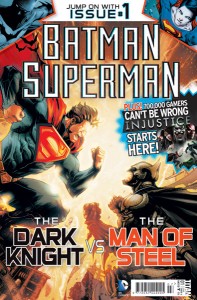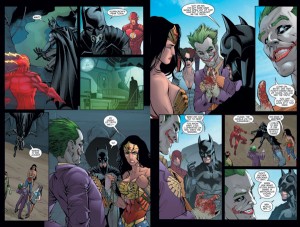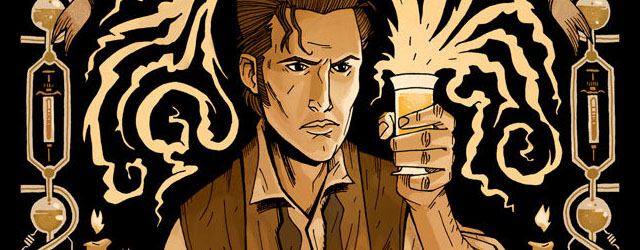 Batman/Superman #1
Batman/Superman #1
Publisher: Titan Magazines
Story: Greg Pak (Cross World); Tom Taylor (Injustice: Gods Among Us, Part 1)
Pencils: Jae Lee , Ben Oliver (Cross World); Jheremy Raapack, Mike S. Miller, Axel Gimenez (Injustice: Gods Among Us, Part 1)
Inks: Jae Lee, Ben Oliver (Cross World); Jheremy Raapack, Mike S. Miller, Marc Deering (Injustice: Gods Among Us, Part 1)
Colors: June Chung, Daniel Brown (Cross World); Andrew Elder Injustice: Gods Among Us, Part 1)
Letters: Rob Leigh (Cross World); Wes Abbott (Injustice: Gods Among Us, Part 1)
Batman/Superman is a brand new comic for the United Kingdom, published by Titan Comics, which collects stories featuring both the Dark Knight and the Man of Steel. The first issue of this bi-monthly comic contains the first issue of the New 52 U.S. monthly comic, Batman/Superman, as well as chapters 1-4 of the U.S. digital-first comic Injustice: Gods Among Us. As such, this is a bit difficult to review, as it’s essentially reviewing two different comics at the same time. To make things easier, we’ve divided the review in half to focus on each separate story individually.
Batman/Superman: Cross Worlds
This is a story that was released to much fanfare when it debuted, featuring fan favorites, author Greg Pak and artist Jae Lee, and focusing on the “first meeting” of Batman and Superman in DC’s New 52 continuity. The deck was stacked to deliver a fantastic story with beautiful art, and this first part of the story delivered on that promise.
Regular readers of the New 52 may be a bit confused over how this could be the “first meeting” of Batman and Superman, given that we had supposedly already glimpsed that fateful encounter in the first issue of the New 52’s Justice League #1. However, Batman/Superman provides an interesting new take that doesn’t negate what happened in that issue, but puts it in a new context. The title of this first arc, “Cross Worlds,” presages what’s to come as the story unfolds, and Greg Pak handles it well.

There are a lot of things to follow in this arc, including flashbacks, time travel, multiple versions of Batman and Superman, old villains, a new villain, and yes, other “worlds.” Yet through it all, Pak delivers a story that never confuses or contradicts itself, making things easy to follow. His characterizations of Batman and Superman are spot-on; in fact, he writes what is arguably the best depiction of Superman in the New 52 to date. He also writes one of the best initial meetings of Batman and Superman, in their civilian identifies of Bruce Wayne and Clark Kent, that I’ve ever read in my decades of comic reading, and then follows it up with a spectacular take on the two heroes meeting again in their costumed identities. Then he blows our minds by mixing things up with different versions of the characters meeting each other throughout both time and space. And all of that is in the first issue alone. There’s absolutely no way as a reader that you can finish this first part of the story and not want to find out what happens next.
On art duties, Jae Lee brings a very unique style to the book, and it’s one that’s very well suited to depicting much of the urban landscapes in this issue, particularly the Gothic cityscapes of Gotham City. Anyone who saw Lee’s work in Before Watchman: Ozymandias knows what I’m talking about here. Combined with the coloring of June Chung, Lee’s artwork creates an almost painterly quality that elevates Batman and Superman into the epic characters they are, akin to a Baroque painting of mythological heroes. However, as much as I truly enjoy Lee’s art and his figure work, he does seem to almost neglect his backgrounds, sometimes giving them a cursory sketch, and other times ignoring them completely. That’s a minor quibble, though, for what is otherwise a beautifully rendered story.
The last few pages of the story are penciled and inked by Ben Oliver, and while it makes sense within the context of the story to change art styles, it is a bit jarring for the reader. Oliver is an excellent draftsman, but his style just doesn’t mesh well with Lee’s; it almost looks unfinished by comparison.
The main conflict in the issue is in the form of a mysterious character that we barely get to meet until the very last panel of the story, except for a few scenes where she is controlling the actions of everyone’s favorite cat burglar. However, her body-snatcher power does make her an interesting match for the Dark Knight Detective and the Man of Steel, and provides a fun, darkly supernatural vibe to the story. You’ll definitely want to learn more about this villain who so ably tricked two of DC’s most iconic heroes in future issues of the story.
Injustice: Gods Among Us (Part 1)
I’m not a video gamer by nature. I’ve got an old PS2 system, a gift from a friend years ago when he upgraded to PS3, languishing in my entertainment console with a stack of dusty games sitting on top of it that a friend let me “borrow” about five years ago. I’ve not played one of them. So, this little snapshot gives you a bit of background into why, when the Injustice: Gods Among Us comic tie-in was released here in the U.S. early last year, I didn’t give it a second glance. My experience has been that comic adaptations of video game properties are typically not given a lot of attention, and are a simple money-grab to try to capitalize on a popular fad at the moment. I get the appeal of playing a video game where I can pit my favorite DC heroes against each other, but had no interest in reading a comic novelization of it.

I couldn’t have been more wrong. This comic reads like an old “Elseworlds” tale, telling the story of an alternate reality in which something so tragic happens to Superman that he ends up becoming a dictator for the entire world. This premise has been used for other stories in the past, but this is a fresh new take, and one that’s much darker than other versions I’ve seen. For fans of the video game, this story takes place before the start of the game and provides the background behind why the heroes are fighting each other. Having this actually helps to ground the game a bit more and move it away from what I had otherwise assumed was simply a modern take on the old CapCom fighting games from the 1990s.
As this story falls outside the continuity of the main DCU and is clearly an alternative version of the future, write Tom Taylor can take some risks, and he does so quite liberally in these first four chapters of the story. Included herein is one of the darkest, most sadistic Joker stories I have ever read. We also get to see major characters die, and in this case those deaths actually have an impact since we can assume that there’s not going to be an Injustice “reboot” or some kind of contrived situation to bring them back to life. Taylor’s writing is gripping and engaging; after having read this first part of the story, I was intrigued enough to order the trade version over here in the States from my local comic shop. I had to order it because the manager told me it’s so popular he can’t keep it in stock. I’m looking forward to seeing how the events in this first part play out in the future of this world Taylor has created, and I can’t imagine anyone else reading the story wouldn’t have this same reaction.
On the downside, the story is incredibly dark. It works for this subject matter, but ever since the relaunch of the New 52, it just seems that much of the joy has been taken out of the DCU. This particular story is no exception, but Taylor does actually include a couple of nice scenes (mainly involving Harley Quinn) that are written purely for the humorous aspect, to slightly lighten up what could otherwise bog down into a pretty depressing read.
The pencils and inks are provided by three different artists. When reading these individually as short 99-cent digital comics online (which is how this story was originally published), that probably wouldn’t matter as much, as each chapter would stand apart. However, when reading them in trade format like this as a continuous story, the change in artistic style is quite jarring. Jheremy Raapack’s style is vibrant and full of energy, but sometimes it looks a bit rough and almost unfinished. If it were consistent it probably wouldn’t stand out as much, but as we move from panel to panel, some figures are depicted fully formed and inked, and others appear almost like sketches that weren’t completed. The next section is by Mike S. Miller, and it’s a clear change from Raapack. Like Raapack, Miller inks his own pencils, and his inking is much smoother and more fluid. He has a strong sense of composition, using extreme “camera angles” to create drama and tension. Lastly, Axel Gimenez provides the penciling on the last section of the story, and while his figure work is quite strong, unfortunately his Superman doesn’t look anything like the version provided by the previous two artists. While we can extend some latitude and understand that artists change books from time-to-time, given the length of these stories, this is akin to having three artists with completely different styles all illustrating one single monthly comic. Taken individually, the work from each artist is good, but taken as a whole in this format, it contributes to a less satisfactory viewing experience.
Overall, this comic of stories featuring two of DC’s most popular heroes is sure to be a major hit “across the pond,” and having the two stories in the same comic is an interesting way to approach these characters, as the stories and the art couldn’t be more different from each other. In one story, we get a main continuity story about the initial meeting of Batman and Superman in the New 52 with Jae Lee’s unique artistic style, and in the other, a dark, twisted tale of how Superman became a tyrant in an alternate reality, with a variety of different artistic interpretations throughout the story. Both are strong stories, and combining them together into this bi-monthly magazine is a great way for readers to catch up on two great story lines at once.
Review copy provided by Titan Comics.
Martin Thomas
@comicattack.net


